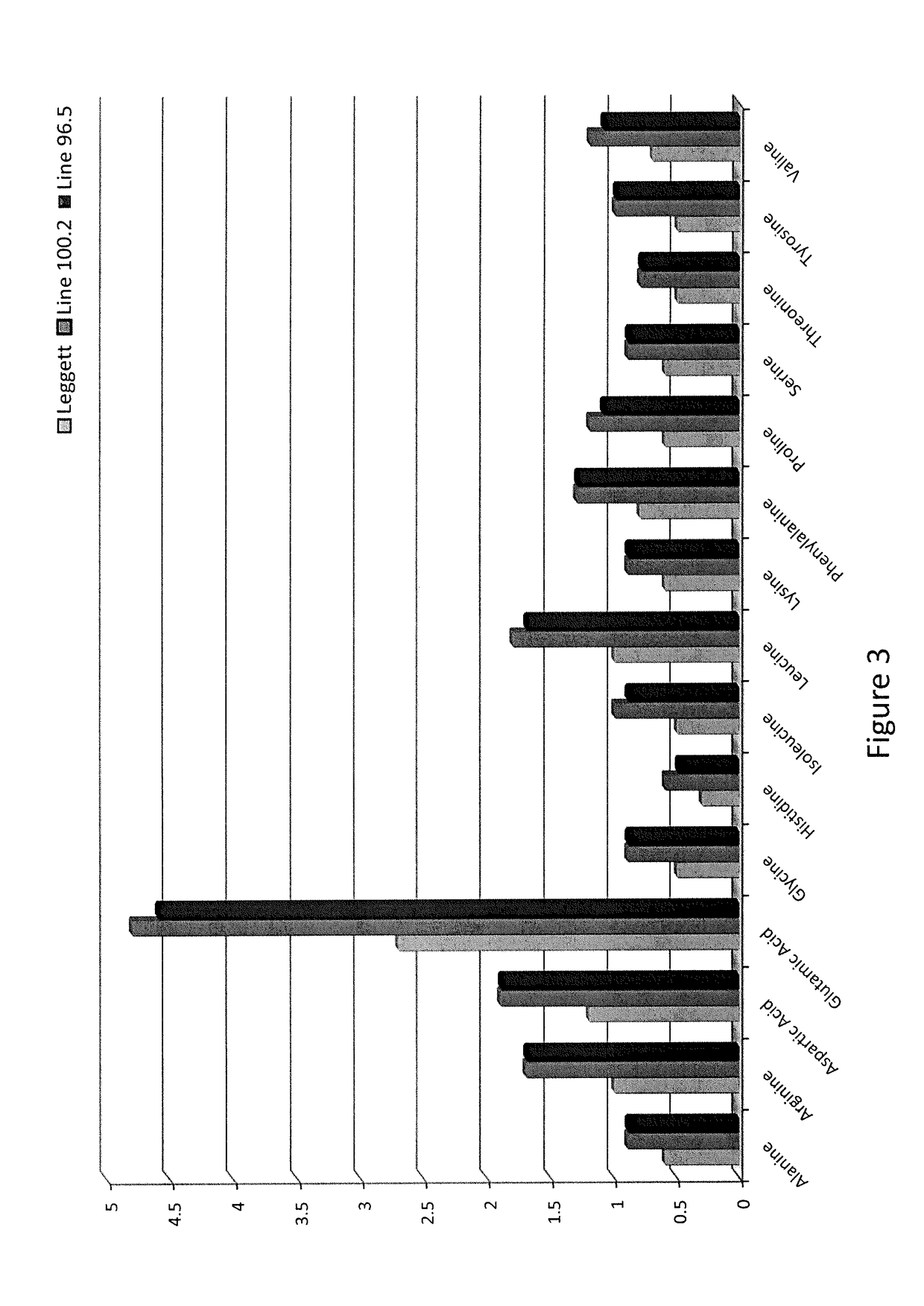High Protein Oat Species
a high protein, oat technology, applied in the field of oat breeding, can solve the problems of difficult to domesticate wild oat species for large-scale production, hairy seeds and difficult hulling of seeds, and wild varieties may not even possess the genetic material for cultivation traits, etc., to achieve good taste and fatty acid distribution, high protein content, and high iron content
- Summary
- Abstract
- Description
- Claims
- Application Information
AI Technical Summary
Benefits of technology
Problems solved by technology
Method used
Image
Examples
example 1
d Oat Line Agronomic Traits
[0052]Several tetraploid oat lines were developed displaying one or more traits suitable for cultivation using one or more standard farming practices. Avena magna ssp domestica lines designated 96.5.6, 96.5.34, 96.5.55, and 100.2.235 display spring habit with erect growth and short stature (≦91.0 cm). Plants head in early-to-mid season and are resistant to lodging and shattering. Stems contain dense green-to-dark green board (≧1.6 mm, penultimate) leaves with erect angles and terminate with long (≧27.0 cm) broad (≧17.8 cm) equilateral panicles. The panicles have a straight hairless rachis that is highly branched and produces abundant spikelets (≧18.0). The spikelets are white-to-yellow in color and display basal semi-abscission without scars or hairs. Spikelets contain an average of two fertile florets (≦3.8% sterility) with long (≧2.8 mm) glumes that are yellow in color. Spikelets for lines 96.5.6 and 96.5.34 contain yellow hairless lemma, while 100.2.235...
example 2
d Oat Line Nutritional Traits
[0057]FIG. 2 is a graph showing the grain content of fats, amino acids, fatty acids as measured in whole grain flour of A. magna ssp domestica line 100.2 and 96.5 compared to Leggett. As can be seen the varieties of the invention are higher in zinc, protein, amino acid, unsaturated and polyunsaturated fatty acids.
[0058]FIG. 3 is a graph showing the amino acid content and distribution of line 100.2 and line 96.5 compared to Leggett as measured in whole grain flour. The graph demonstrates that the varieties of the invention are much higher in arginine, glutamic and aspartic acids compared to Leggett, and are in fact, higher in every amino acid.
[0059]FIG. 4 is a graph showing the fatty acid content and distribution of line 100.2 and line 96.5 compared to Leggett as measured in whole grain flour. The graph shows that the varieties of the invention are much higher in oleic acid, linoleic, linolenic and palmitic, the unsaturated fatty acids that stear...
example 3
d Oat Line Genetics
[0078]Genotypic relationship of tetraploid oat lines to A. sativa varieties and wild type A. magna, A. moroccana, A. murphyii, and A. strigosa accessions was compared based on allele sharing and hierarchical clustering using the following materials and methods.
[0079]Genotyping.
[0080]DNA from leaf tissue was extracted using the Qiagen DNeasy 96 Plant Kit (Qiagen, Hilden) and quantified using PicoGreen (LifeTechnologies, Carlsbad). After DNA quantification and normalization to 20 ng / μL, samples were prepared for sequencing using a modified double-restriction enzyme digestion protocol (Poland et al., 2012, PLoS ONE, 7.2:e32253). In brief, total genomic DNA (100 ng) was digested with 5 U of PstI-HF and MspI endonucleases (New England Biolabs, Ipswich) in a 10×NEB CutSmart buffer (1× final concentration). Thermocycler conditions for digestion were 34° C. for 120 minutes followed by 65° C. for 20 minutes. The restricted DNA was then ligated to forward adapters designed ...
PUM
 Login to View More
Login to View More Abstract
Description
Claims
Application Information
 Login to View More
Login to View More - R&D
- Intellectual Property
- Life Sciences
- Materials
- Tech Scout
- Unparalleled Data Quality
- Higher Quality Content
- 60% Fewer Hallucinations
Browse by: Latest US Patents, China's latest patents, Technical Efficacy Thesaurus, Application Domain, Technology Topic, Popular Technical Reports.
© 2025 PatSnap. All rights reserved.Legal|Privacy policy|Modern Slavery Act Transparency Statement|Sitemap|About US| Contact US: help@patsnap.com



